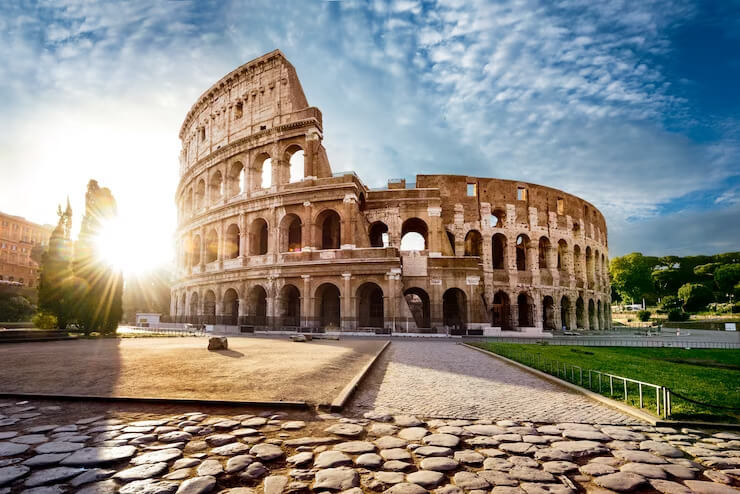Updated October 19, 2023
Introduction to The Colosseum, Rome
The massive stone arena of the Colosseum, Rome, located east of the Roman Forum, was a gift to the Roman people between 70 and 72 A.D. by Emperor Vespasian of the Flavian dynasty. Titus, Vespasian’s son, dedicated the Colosseum, also known as the Flavian Amphitheater, in the year 80 A.D. with a 100-day celebration that included gladiatorial battles and animal fights. Before it left, the beautiful arena was continuously used for four centuries. In addition, it was a source of building materials until the 18th century. The old Colosseum, now just two-thirds of its original size, is a popular tourist destination and a venerated image of Rome and its history.
History
The Colosseum is Rome’s most recognizable landmark. It’s a gigantic structure with over 2,000 years of history that will transport you back to learning about Roman Empire life. The Colosseum was 72 under Vespasian’s empire and finished in 80 under Titus’ rule. When completed, the Colosseum was the most significant Roman theater in the world, measuring 188 meters in length, 156 meters in width, and 57 meters in height.
Below is a brief history of the Colosseum, Rome:
- The Colosseum operated as the city’s theater until the fall of the Roman Empire. Criminal defendants, lions, and gladiators frequently engaged in death-defying battles in this arena.
- Since the fall of the Roman Empire, the Colosseum, Rome has been under harmful pressures, including center stone and marble looting and natural disasters such as earthquakes.
- Indeed, some well-known Roman constructions benefited from its resources, notably St. Peter’s Cathedral and the Palazzo Venezia. Nevertheless, despite losing a third of the Colosseum to time, it remains one of the world’s most fascinating and spectacular historical structures.
Why was The Colosseum, Rome, Built?
In 69 A.D., the Flavian Dynasty established itself. The Flavian Dynasty has given to Vespasian and his two sons, Titus and Domitian. They controlled the Roman Empire as a family from 69 to 96 A.D. Despite their family’s brief reign, the Colosseum, Rome erected during their reign, along with other notable historical, economic, and military events.
Under the Flavian political administration of Rome, the tower served as much more than merely a site for entertainment. Vespasian believed it would help to stabilize the Flavian dynasty. He began constructing the Flavian Amphitheatre as part of a massive propaganda campaign. Titus, his eldest son, would later complete the structure. The Flavian Amphitheatre is now more often known as Colosseum.
Architecture and Design of The Colosseum, Rome
The Flavian Emperors, Vespasian, Titus, and Domitian, oversaw the construction of the Colosseum between 70 and 80 A.D., which is why the Amphitheatrum Flavium, often known as the Flavian Amphitheater, has created. Vespasian’s construction of the Colosseum could be a populist initiative.
Vespasian built the Colosseum, at least partly, to regain the allegiance of a public unhappy with the imperial institution after Nero’s reign. Planning for the artificial lake Nero built as part of the Domus Aurea began in 70 A.D., and construction began in 72 A.D. Most of the labor on the structure was by Jewish enslaved people who had been prisoners following the first Jewish-Roman fight.
What is there to do at The Colosseum, Rome?
Let’s discuss what could be at the Colosseum:
- Before entering, your journey begins with a memorable first impression of the Colosseum. Then, with imperious majesty, the majestic north side overtakes the disintegrating ruin of the south side.
- The ornate 57-meter-tall structure has built using Travertine marble from quarries around Italy. In Rome, smiling broadly when you pose for photos in front of the Colosseum is nearly normal. While the position may appear excessive, you will appreciate the moment for the rest of your life.
- View the arena from above as you go around the amphitheater. Ancient Roman society’s wealthiest and most influential members would have access to the Colosseum’s second story.
- The Colosseum may be from a vantage point high above the arena spectators. The experience includes marveling at the building’s massive size, beautiful stonework, and general magnificence.
- There are small displays and information desks on the second floor. In addition, you can learn more about the history of the Colosseum by examining historical artifacts uncovered during archaeological digs.
- After visiting the Colosseum, you can take the Rome to Florence to Venice train to enjoy the Cathedral in Florence and Doge’s palace in Venice.
Interesting Facts About The Colosseum, Rome
Let’s discuss some of the interesting facts about the Colosseum:
- Gladiator fights and wild animal hunts are well-known events. But did you know that naval battles used to take place in the Colosseum? Emperor Titus ordered the Colosseum to portray a famous naval war between Syracuse and Athens.
- The formal name of the Colosseum, Rome, was first adopted as Flavian Amphitheater. However, the term Colosseum is to have originated with the Colossus of Nero, a colossal bronze monolith that once stood nearby.
- The Roman Colosseum was one of the “New Seven Wonders of the World” in 2007.
- Because the emperors usually covered the cost of maintaining goodwill among the public, the largest shows frequently offered free entrance.
Conclusion
Given everything discussed thus far, it is possible to conclude that the Coliseum is a beautiful monument reflecting the achievements of ancient Roman architecture and civilization. The Coliseum is one of the greatest works of ancient Roman architects that have survived to the present day.

